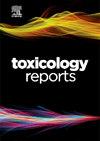基于烟草使用者唾液可替宁产率模型的药物动力学行为可行性评估。
Q1 Environmental Science
引用次数: 0
摘要
方法:对55名Juul电子烟使用者在自然环境中进行的为期17天的两组交叉研究进行了二次分析,使用了雾化地形和唾液可替宁生物标志物数据。该研究扩展了先前验证的基于行为的产量(BBY),该产量将Juul电子烟的气溶胶排放量量化为用户行为的函数。介绍了一种基于行为的药代动力学产率(PkBBY)模型,该模型模拟了尼古丁进入人体及其随后的代谢衰变为可替宁。可利用的参与者数据子集用于训练PkBBY模型并确定三个参数:反映尼古丁转化为唾液可替宁浓度的增益,以及尼古丁和唾液可替宁在体内的半衰期。可用数据的一个单独子集用于评估PkBBY模型对唾液可替宁暴露生物标志物的性能。结果:模型训练表明,PkBBY模型能够在回归的+ /- 220 ng/mL 95 %置信区间内预测参与者的睡前唾液可替宁,基于他们观察到的喷雾剂地形。训练算法估计尼古丁摄入转化为唾液可替宁浓度为28.8 [(ng/mL可替宁)/(mg尼古丁摄入)],尼古丁和可替宁的半衰期分别为4.4和49[小时]。应用于评估数据集的模型的一对一类内相关系数为0.6,表明预测与观察到的生物标志物之间存在适度的一致性。讨论了与可用于二次分析的数据相关的模型的局限性。结论:PkBBY模型得到了内部验证,并有望作为建立吸烟行为与尼古丁暴露的既定生物标志物之间因果关系的工具。需要进一步的工作来开发个性化的PkBBY模型参数,以解释参与者代谢因素的变化。本文章由计算机程序翻译,如有差异,请以英文原文为准。
Feasibility assessment of a pharmaco-kinetic behavior based yield model of salivary cotinine among tobacco users
Methods
A secondary analysis was conducted using puff topography and salivary cotinine biomarker data from a prior two arm, two period cross-over study conducted in the natural environment over 17 days which enrolled 55 Juul electronic cigarette users. The study expands upon a previously validated behavior-based yield (BBY) which quantified aerosol emissions from a Juul ecig as a function of user behavior. A Pharmacokinetic Behavior-Based Yield (PkBBY) model is introduced which models the uptake of nicotine into the body and its subsequent metabolic decay into cotinine. A subset of the available participant data was used to train the PkBBY model and identify three parameters: a gain reflecting the conversion of nicotine into salivary cotinine concentration, and the half-lives of nicotine and salivary cotinine in the body. A separate subset of the available data was used for assessing performance of the PkBBY model against salivary cotinine biomarkers of exposure.
Results
Model training demonstrated the PkBBY model was able to predict the bedtime salivary cotinine of participants within + /- 220 ng/mL 95 % confidence interval on the regression, based on their observed puff topography. The training algorithm estimated the conversion from nicotine ingested into the concentration of salivary cotinine as 28.8 [(ng/mL cotinine)/(mg nicotine ingested)], and the half-lives of nicotine and cotinine to be 4.4 and 49 [hours], respectively. The one-to-one intraclass correlation coefficient of the model applied to the assessment data set was 0.6, indicating moderate agreement between the predictions and the observed biomarkers, Limitations of the model associated with the data available for secondary analysis are discussed.
Conclusions
The PkBBY model was internally validated and shows promise as a tool for establishing a causal relationship between puffing behavior and an established biomarker of nicotine exposure. Further work is needed to develop personalized PkBBY model parameters to account for variations in participant metabolism factors.
求助全文
通过发布文献求助,成功后即可免费获取论文全文。
去求助
来源期刊

Toxicology Reports
Environmental Science-Health, Toxicology and Mutagenesis
CiteScore
7.60
自引率
0.00%
发文量
228
审稿时长
11 weeks
 求助内容:
求助内容: 应助结果提醒方式:
应助结果提醒方式:


